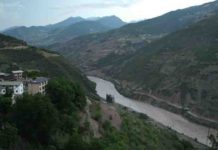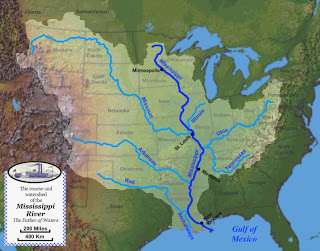
The Mississippi River is the chief river of the largest drainage system in North America. Flowing entirely in the United States (though its drainage basin reaches into Canada), it rises in northern Minnesota and meanders slowly southwards for 2,530 miles (4,070 km) to the Mississippi River Delta at the Gulf of Mexico. With its many tributaries, the Mississippi’s watershed drains all or parts of 31 US states and 2 Canadian provinces between the Rocky and Appalachian Mountains. The Mississippi ranks as the fourth longest and tenth largest river in the world. The river either borders or cuts through the states of Minnesota, Wisconsin, Iowa, Illinois, Missouri, Kentucky, Tennessee, Arkansas, Mississippi, and Louisiana.
Native Americans long lived along the Mississippi and its tributaries. Most were hunter-gatherers or herders, but some, such as the Mound builders, formed prolific agricultural societies. The arrival of Europeans in the 1500s changed the native way of life as first explorers, then settlers, ventured into the basin in increasing numbers. The river served first as barrier – forming borders for New Spain, New France, and the early United States – then as vital transportation artery and communications link. In the 19th century, during the height of Manifest Destiny, the Mississippi and several western tributaries, most notably the Missouri, formed pathways for the western expansion of the United States.
Formed from thick layers of this river’s silt deposits, the Mississippi River Valley is one of the most fertile agricultural regions of the country, which resulted in the river’s storied steamboat era. During the American Civil War, the Mississippi’s capture by Union forces marked a turning point towards victory because of the river’s importance as a route of trade and travel, not least to the Confederacy. Because of substantial growth of cities and the larger ships and barges that supplanted riverboats, the decades following the 1900s saw the construction of massive engineering works such as levees, locks and dams, often built in combination.
Since modern development of the basin began, the Mississippi has also seen its share of pollution and environmental problems – most notably large volumes of agricultural runoff, which has led to the Gulf of Mexico dead zone off the Delta. In recent years, the river has shown a steady shift towards the Atchafalaya River channel in the Delta; a course change would prove disastrous to seaports such as New Orleans. A system of dikes and gates has, so far, held the Mississippi at bay but, due to fluvial processes, the shift becomes more likely each year.
Name
The word Mississippi itself comes from Messipi, the French rendering of the Anishinaabe (Ojibwe or Algonquin) name for the river, Misi-ziibi (Great River). See below in “History” section for additional information.
In addition to historical traditions shown by names, there are at least two other measures of a river’s identity, one being the largest branch (by water volume), and the other being the longest branch. Using the largest-branch criterion, the Ohio (not the Middle and Upper Mississippi) would be the main branch of the Lower Mississippi. Using the longest-branch criterion, the Middle Mississippi-Missouri-Jefferson-Beaverhead-Red Rock-Hellroaring Creek River would be the main branch. According to either school of thought, the Upper Mississippi from Lake Itasca, Minnesota to St. Louis, despite its name, would only be a secondary tributary of the final river flowing from Cairo to the Gulf of Mexico.
While the Missouri River, flowing from the confluence of the Jefferson, Madison and Gallatin Rivers to the Mississippi, is the longest continuously named river in the United States,[4] the serially named river known sequentially as Hellroaring Creek, Red Rock, Beaverhead, Jefferson, Missouri, Middle Mississippi, and Lower Mississippi, as one continuous waterway, is the longest river in North America and the third or fourth longest river in the world. Its length of at least 3,745 mi (6,027 km) is exceeded only by the Nile, the Amazon,[6] and perhaps the Yangtze River[7] among the longest rivers in the world. The source of this waterway is at Brower’s Spring, 8,800 feet (2,700 m) above sea level in southwestern Montana, along the Continental Divide outside Yellowstone National Park.
The Mississippi River is widely considered a convenient if approximate dividing line between the Eastern, Southern, and Midwestern United States and the Western U.S., as exemplified by the Gateway Arch in St. Louis and the phrase “Trans-Mississippi”, used for example in the name of the 1898 Trans-Mississippi Exposition held in Omaha, Nebraska.
Physical geography
Divisions
Upper Mississippi
- The headwaters, 493 miles (793 km), from the source to Saint Anthony Falls in Minneapolis, Minnesota; and
- A navigable channel, formed by a series of man-made lakes between Minneapolis and St. Louis, Missouri, some 664 miles (1,069 km).
From its origin at Lake Itasca to St. Louis, Missouri, the waterway’s flow is moderated by 43 dams. Fourteen of these dams are located above Minneapolis in the headwaters region and serve multiple purposes, including power generation and recreation. The remaining 29 dams, beginning in downtown Minneapolis, all contain locks and were constructed to improve commercial navigation of the upper river. Taken as a whole these 43 dams significantly shape the geography and influence the ecology of the upper river. Beginning just below Saint Paul, Minnesota, and continuing throughout the upper and lower river, the Mississippi is further controlled by thousands of wing dikes that moderate the river’s flow in order to maintain an open navigation channel and prevent the river from eroding its banks.
The head of navigation on the Mississippi is the Coon Rapids Dam in Coon Rapids, Minnesota. Before its construction in 1913, steamboats could occasionally go upstream as far as Saint Cloud, Minnesota, depending on river conditions.
The uppermost lock and dam on the Upper Mississippi River is the Upper St. Anthony Falls Lock and Dam in Minneapolis. Above the dam, the river’s elevation is 799 feet (244 m). Below the dam, the river’s elevation is 750 feet (230 m). This 49-foot (15 m) drop is the largest of all the Mississippi River locks and dams. The origin of the dramatic drop is a waterfall preserved adjacent to the lock under an apron of concrete. Saint Anthony Falls is the only true waterfall on the entire Mississippi River. The water elevation continues to drop steeply as it passes through the gorge carved by the waterfall.
The Upper Mississippi features various natural and artificial lakes, with its widest point being Lake Winnibigoshish, near Grand Rapids, Minnesota, over 7 miles (11 km) across. Also of note is Lake Onalaska (created by Lock and Dam No. 7), near La Crosse, Wisconsin, over 4 miles (6.4 km) wide. On the other hand, Lake Pepin is natural, formed due to the delta formed by the Chippewa River of Wisconsin as it enters the Upper Mississippi; it is more than 2 miles (3.2 km) wide.
By the time the Upper Mississippi reaches Saint Paul, Minnesota, below Lock and Dam No. 1, it has dropped more than half its original elevation and is 687 feet (209 m) above sea level. From St. Paul to St. Louis, Missouri, the river elevation falls much more slowly, and is controlled and managed as a series of pools created by 26 locks and dams.
The Upper Mississippi River is joined by the Minnesota River at Fort Snelling in the Twin Cities; the St. Croix River near Prescott, Wisconsin; the Cannon River near Red Wing, Minnesota; the Zumbro River at Wabasha, Minnesota; the Black, La Crosse, and Root rivers in La Crosse, Wisconsin; the Wisconsin River at Prairie du Chien, Wisconsin; the Rock River at the Quad Cities; the Iowa River near Wapello, Iowa; the Skunk River south of Burlington, Iowa; and the Des Moines River at Keokuk, Iowa. Other major tributaries of the Upper Mississippi include the Crow River in Minnesota, the Chippewa River in Wisconsin, the Maquoketa River and the Wapsipinicon River in Iowa, and the Big Muddy River and Illinois River.
The Upper Mississippi is largely a multi-thread stream with many bars and islands. From its confluence with the St. Croix River downstream to Dubuque, Iowa, the river is entrenched, with high bedrock bluffs lying on either side. The height of these bluffs decreases to the south of Dubuque, though they are still significant through Savanna, Illinois. This topography contrasts strongly with the Lower Mississippi, which is a meandering river in a broad, flat area, only rarely flowing alongside a bluff (as at Vicksburg, Mississippi).
Middle Mississippi
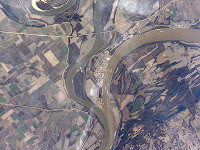
The Mississippi River is known as the Middle Mississippi from the Upper Mississippi River’s confluence with the Missouri River at St. Louis, Missouri, for 190 miles (310 km) to its confluence with the Ohio River at Cairo, Illinois.
The Middle Mississippi is a relatively free-flowing river. From St. Louis to the Ohio River confluence, the Middle Mississippi falls a total of 220 feet (67 m) over a distance of 180 miles (290 km) for an average rate of 1.2 feet per mile (23 cm/km). At its confluence with the Ohio River, the Middle Mississippi is 315 feet (96 m) above sea level. Apart from the Missouri River and Meramec River which originates in central Missouri, along with the Kaskaskia River in Illinois, no major tributaries enter the Middle Mississippi River.
Lower Mississippi
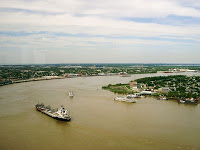
The Mississippi River is called the Lower Mississippi River from its confluence with the Ohio River to its mouth at the Gulf of Mexico. Measured by water volume, the Lower Mississippi’s primary branch is the Ohio River. At the confluence of the Ohio and the Middle Mississippi, the Ohio is the bigger river, with its long-term mean discharge at Cairo, Illinois being 281,500 cu ft/s (7,970 m3/s), while the long-term mean discharge of the Mississippi at Thebes, Illinois (just upriver from Cairo) is 208,200 cu ft/s (5,900 m3/s). Thus, by volume, the main branch of the Mississippi River system at Cairo can be considered to be the Ohio River (and the Allegheny River further upstream), rather than the Middle Mississippi.
In addition to the Ohio River, the major tributaries of the Lower Mississippi River are the White River, flowing in at the White River National Wildlife Refuge in east central Arkansas; the Arkansas River, joining the Mississippi at Arkansas Post; the Big Black River in Mississippi; the Yazoo River, meeting the Mississippi at Vicksburg, Mississippi; and the Red River in Louisiana. The widest point of the Mississippi River is in the Lower Mississippi portion where it exceeds 1 mile (1.6 km) in width in several places.
Deliberate water diversion at the Old River Control Structure in Louisiana allows the Atchafalaya River in Louisiana to be a major distributary of the Mississippi River, with 30% of the Mississippi flowing to the Gulf of Mexico by this route, rather than continuing down the Mississippi’s current channel past Baton Rouge and New Orleans on a longer route to the Gulf.
Watershed
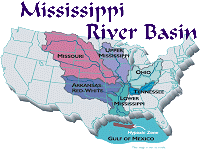
The Mississippi River has the world’s fourth largest drainage basin (“watershed” or “catchment”). The basin covers more than 1,245,000 sq mi (3,220,000 km2), including all or parts of 32 U.S. states and two Canadian provinces. The drainage basin empties into the Gulf of Mexico, part of the Atlantic Ocean. The total catchment of the Mississippi River covers nearly 40% of the landmass of the continental United States.
In the United States, the Mississippi River drains the majority of the area between crest of the Rocky Mountains and the crest of the Appalachian Mountains, except for various regions drained to Hudson Bay by the Red River of the North; to the Atlantic Ocean by the Great Lakes and the Saint Lawrence River; and to the Gulf of Mexico by the Rio Grande, the Alabama and Tombigbee rivers, the Chattahoochee and Appalachicola rivers, and various smaller coastal waterways along the Gulf.
The Mississippi River empties into the Gulf of Mexico about 100 miles (160 km) downstream from New Orleans. Measurements of the length of the Mississippi from Lake Itasca to the Gulf of Mexico vary somewhat, but the United States Geological Survey’s number is 2,340 miles (3,770 km). The retention time from Lake Itasca to the Gulf is typically about 90 days.
Outflow
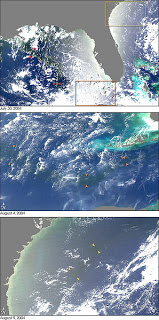
The Mississippi River discharges at an annual average rate of between 200 and 700 thousand cubic feet per second (7,000–20,000 m3/s). Although it is the 5th largest river in the world by volume, this flow is a mere fraction of the output of the Amazon, which moves nearly 7 million cubic feet per second (200,000 m3/s) during wet seasons. On average, the Mississippi has only 8% the flow of the Amazon River.
Fresh river water flowing from the Mississippi into the Gulf of Mexico does not mix into the salt water immediately. The images from NASA’s MODIS (to the right) show a large plume of fresh water, which appears as a dark ribbon against the lighter-blue surrounding waters. These images demonstrate that the plume did not mix with the surrounding sea water immediately. Instead, it stayed intact as it flowed through the Gulf of Mexico, into the Straits of Florida, and entered the Gulf Stream. The Mississippi River water rounded the tip of Florida and traveled up the southeast coast to the latitude of Georgia before finally mixing in so thoroughly with the ocean that it could no longer be detected by MODIS.
Prior to 1900, the Mississippi River transported an estimated 400 million metric tons of sediment per year from the interior of the United States to coastal Louisiana and the Gulf of Mexico. During the last two decades, this number was only 145 million metric tons per year. The reduction in sediment transported down the Mississippi River is the result of engineering modification of the Mississippi, Missouri, and Ohio rivers and their tributaries by dams, meander cutoffs, river-training structures, and bank revetments and soil erosion control programs in the areas drained by them.
Course changes
Over geologic time, the Mississippi River has experienced numerous large and small changes to its main course, as well as additions, deletions, and other changes among its numerous tributaries, and the lower Mississippi River has used different pathways as its main channel to the Gulf of Mexico across the delta region.
Through a natural process known as avulsion or delta switching, the lower Mississippi River has shifted its final course to the mouth of the Gulf of Mexico every thousand years or so. This occurs because the deposits of silt and sediment begin to clog its channel, raising the river’s level and causing it to eventually find a steeper, more direct route to the Gulf of Mexico. The abandoned distributaries diminish in volume and form what are known as bayous. This process has, over the past 5,000 years, caused the coastline of south Louisiana to advance toward the Gulf from 15 to 50 miles (25–80 km). The currently active delta lobe is called the Birdfoot Delta, after its shape, or the Balize Delta, after La Balize, Louisiana, the first French settlement at the mouth of the Mississippi.
Prehistoric courses
The current form of the Mississippi River basin was largely shaped by the Laurentide Ice Sheet of the most recent Ice Age. The southernmost extent of this enormous glaciation extended well into the present-day United States and Mississippi basin. When the ice sheet began to recede, hundreds of feet of rich sediment were deposited, creating the flat and fertile landscape of the Mississippi Valley. During the melt, giant glacial rivers found drainage paths into the Mississippi watershed, creating such features as the Minnesota River, James River, and Milk River valleys. When the ice sheet completely retreated, many of these “temporary” rivers found paths to Hudson Bay or the Arctic Ocean, leaving the Mississippi Basin with many features “oversized” for the existing rivers to have carved in the same time period.
Ice sheets during the Illinoian Stage about 300,000 to 132,000 years before present, blocked the Mississippi near Rock Island, Illinois, diverting it to its present channel farther to the west, the current western border of Illinois. The Hennepin Canal roughly follows the ancient channel of the Mississippi downstream from Rock Island to Hennepin, Illinois. South of Hennepin, to Alton, Illinois, the current Illinois River follows the ancient channel used by the Mississippi River before the Illinoian Stage.



